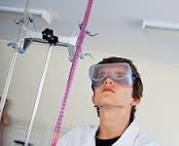Lab report for Chemistry(Reaction between Crystal Violet and Sodium Hydroxide)
Write chemistry a lab report for a reaction between Crystal violet and Sodium hydroxide when the following are provided:
0.005M Sodium
hydroxide, 6.75 X 10-6M crystal violet for first run of the
experiment. In the second run, replace 0.005M sodium hydroxide with 0.01M
sodium hydroxide. Use the questions given below to guide you write a good report.
Which function At
versus time gives the most linear graph (-A, -ln A, 1/A)? The result for this experiment was ln(A).
The order of reaction of
crystal violet is (0, 1, 2): y=1, y=0.0015x – 0.2195. The experimental values for
pseudo rate constants (include significant figures and units).
Results: K’ = -0.0015, K” = -0.003 (Include graphs to
illustrate your answers)
y=-0.003x – 0.813, rate
of two pseudo constants k”/k’ = (-0.003/-0.0015) = 2. The order of reaction in
sodium hydroxide is (0, 1, 2) x=1.
Calculate the value of true rate constant, K, from the experimental value for K’, (include your calculations
and units).
Calculate the value of
true rate constant K, from the experimental value for K” (show your
calculations, including units).
Average experimental
value for K (include significant figures and units). Answer for is -0.294.
Calculate molar absorptive, €, for crystal violet using the data from part 1(show your calculations).
Calculate molar absorptive, €, for crystal violet using the data from part 1(show your calculations).
Introduction
Chemical kinetics is considered as the study of rates of
a reaction. In this experiment, the kinetics of the reaction between sodium
hydroxide and crystal violet was investigated. The concentration of crystal violet as
a function of time was also monitored. The molecular reaction equations is as shown
below.
The crystal
violet color is caused by the extensive system of alternating double
and single bonds, which extend over the central carbon atom and all three
benzene rings. If the conjugation in the crystal violet structure is traced, it
is noted that in the reaction product, the three rings become no longer in
conjugation with one another, and hence, this makes the material colorless.
Procedure
Before
beginning of the procedure, a transmittance calibration was conducted on the
spectrometer. [%T with no Cuvet (left knob); 100%T with H2O Cuvet (right knob)]
distilled water was used as a blank. The outside of the Cuvet was wiped dry. The Cuvet was emptied and shaken dry. On an excel
spreadsheet, columns of time, ABS and %T were set up. Two graphs of %T versus
time and ABS versus time were generated on the same spreadsheet. A solution of
crystal violet was dispensed inside a clean dry beaker after which a solution of
NaOH was dispensed into the beaker immediately without splashing it.
The solution of CV and NaOH was mixed thoroughly, followed by filling the the Cuvet upto ¾ full. %T readings were taken at time intervals using a spectrometer. [CV]t was computed for each data point in the excel sheet using Beer’s law. A plot of
1/[CV]t versus time was generated. A linearity test was carried out .The first order reaction in CV gave a linear plot while a second order
reaction gave a curved plot.
Results and Data
Value of true rate constant k’ as calculated from the experimental value k’:
First experiment:
Rate= (--0.0015) X (6.75X10-6)
-1 X10-8=k (0.005) (6.75 X 10-6)
-1X10-8=k (0.005) (6.75X10-6)
-1X10-8=k (3.4 X10-6)
Value of true rate constant k’ as calculated from the experimental value k”:
Second experiment:
Rate= (-0.003) X (6.75 X 10-6) = -2 X 10-8
-2 X 10-8 =k (0.01) (6.75 X10-6)
-2 X 10-8 = k (6.8 x 10-8) =
-0.294
Min--0.294min-1.
Average experimental value for k was -0.294 min-1.
Molar absorptivity, €,
of crystal violet calculated using the data from part one:
At = -log
(%T/100) =E {cr}t
Where At = 0.985, E = 2.54 cm [cr]t = 6.75
* 10-6
(0.985)/ (2.54) X (6.75
X 10-6) = € = 57451.153
Conclusion
For the
graphs obtained using NaOH with the lower concentration level, the plot of Absorbance
against time yielded the straightest line, but the plot of lnA against time also
had a very straight line. The plot of 1/A gave the line that was slightly straight. For the graphs that were obtained using NaOH of a higher
concentration, lnA against time had the straightest line. The graphs of
absorbance against time and 1/A against time were not as nearly straight. It
is, therefore, fairly safe to say that the rate equation was in first order because
lnA against time overall yielded the straightest line in the two runs. Hence, the rate equation of the reaction with respect to hydroxide ions was = k [NaOH].







apple nutrition facts
ReplyDelete